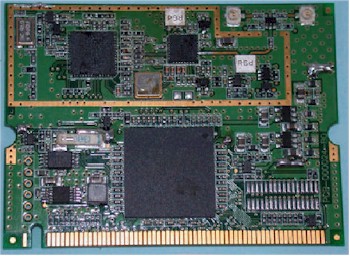Basic Features and Internal details
The 5450 comes in a plastic charcoal gray enclosure about the size of a VHS cassette. The PWR, Tx / Rx, and Warn indicators on the slightly sloped front of the box are viewable in most situations except for high-up horizontal mounting. The Tx / Rx is steadily illuminated and blinks at just the right rate when there's wireless network activity, while the Warn indicator lights up if a MAC address-filtered client attempts to gain WLAN access. There are no slots provided for wall mounting and no stand or other means to orient it vertically on a desktop or shelf.
The Ethernet 10/100 port and power jack are on the rear panel, along with a reset switch that does double duty as a reset-to-factory-defaults-switch, two RP-SMA antenna connectors, and a DB-9F serial connector (more on this shortly).
I can't tell you which processor USR chose to base the 5450 on because it's hidden under a heatsink. But I can tell you that a the radio is manufactured by Global Sun and is based on Texas Instruments' TNETW1130 Multimode wireless chipset. You can see it in Figure 1 with RF shielding removed.

Figure 1: Global Sun mini-PCI radio
There's not much else inside besides RAM, Flash memory, Kendin KS8721B Ethernet PHY and an Altera PLD. I found that the Ethernet connector is wired for Power Over Ethernet, although USR is not specing or supporting the feature. The dual dipole antennas that seem to dwarf the 5450's enclosure attach via two increasingly popular RP-SMA connectors, so can be replaced with higher-gain alternatives should you need to.